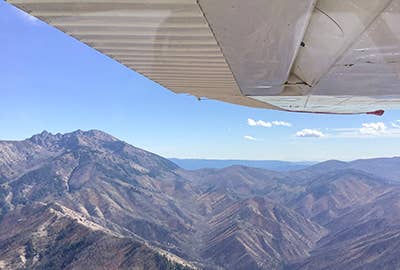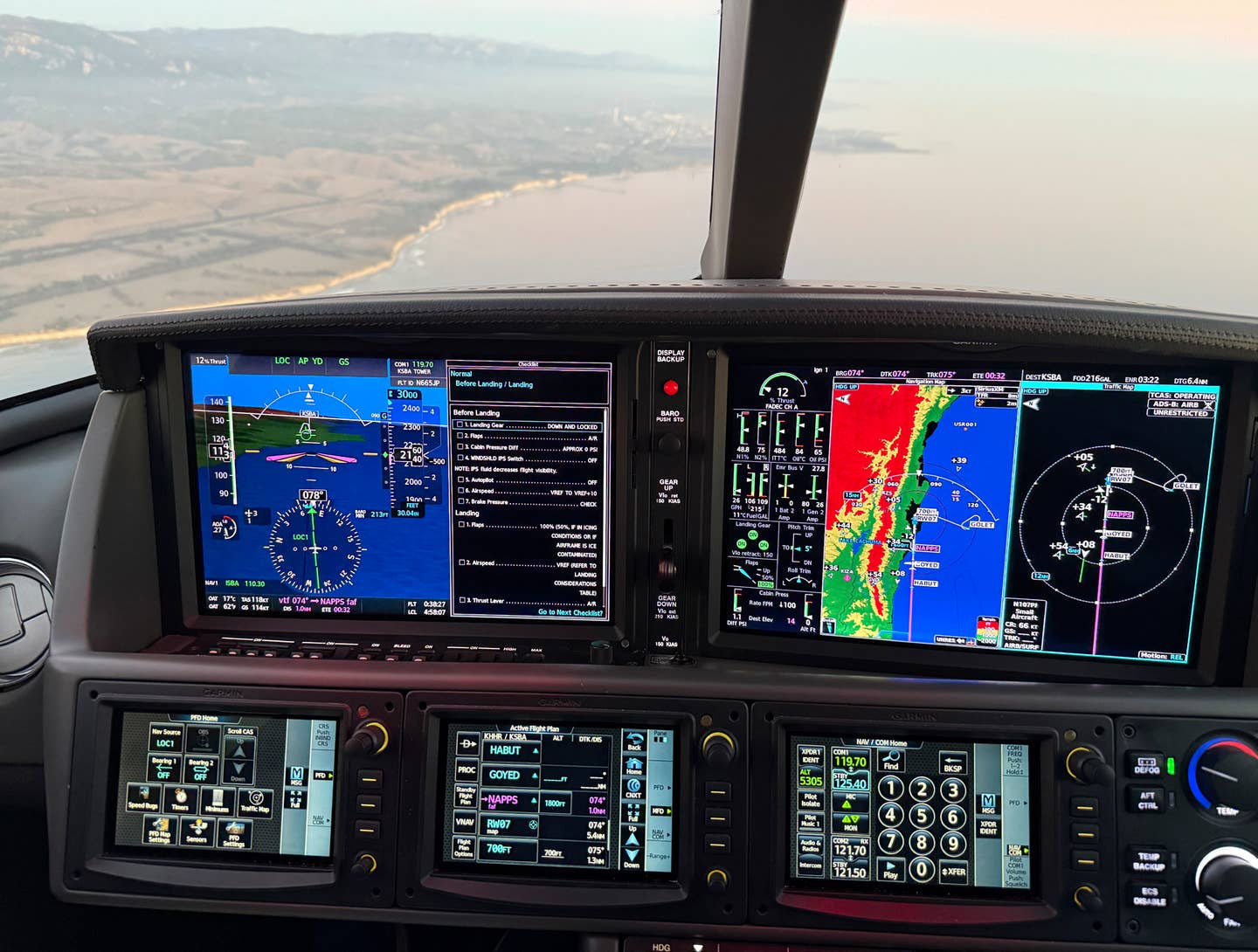
Try to pick a route that takes you near roads. Even unpaved ones can make for better landing sites than more remote locations. Julie Boatman
Editor’s note: FLYING staff writer and CFI Meg Godlewski is an expert on survival techniques for pilots. She wrote the survival chapter of AOPA’s ground school for CFIs. In this two-part series, she counsels pilots on how to avoid the potential disasters of an unscheduled, off-airport landing, as well as how you can survive if one of those disasters happens to you. Read Part 1 here.
Here’s Part 2: How to Survive
The best way to survive an unscheduled, off-airport landing in hostile terrain is to minimize the risk of having one.
Plan your flight so that there are airports along your route in case of an emergency that results in an unscheduled landing. This is particularly important in mountainous terrain. When you study a sectional chart—whether digital or paper—of these areas, take note of the other-than-hard-surfaced runways next to highways that traverse the mountains. Many of these were built in the 1930s, when airline travel was in its infancy, so the aircraft that crossed the mountains would have a place to land in an emergency.
File & Flight Following
Student pilots learn how to file, open and close a flight plan, and how to obtain flight following. The idea is that if the worst happens, people will know where to look for you. Pilots are taught to close their flight plan after landing, with the caveat that if you fail to close your flight plan within 30 minutes of your ETA, a search begins, and if it’s done needlessly because the pilot simply forgot to close their flight plane, that pilot pays for it.
This makes some pilots reluctant to file and activate flight plans. They’ve heard horror stories about pilots who forgot—and received a very expensive bill when search and rescue is needlessly launched.
There are several ways to avoid this situation:
- Create a reminder for yourself, like setting the alarm on your phone.
- Tap the appropriate button on your tablet if you’re using ForeFlight.
- Go low-tech—if you wear a wristwatch, move it to the other wrist during the flight—it feels weird, and when you land, it reminds you to close the flight plan.
- Or write “CLOSE FLIGHT PLAN” on a note and place it in the waistband of your pants. Since one of the first things pilots do when they land is to visit the lavatory, you’ll find that note and be able to make a telephone call to close the plan.
If you’re able, use flight following. ATC will keep an eye on you, and if there is a problem, they’ll know where to send help. At the very least, you need to let a responsible person know where you are going. Some flight schools have a policy that renter pilots and learners leave a copy of their nav log at the front desk with the dispatch person.
Some CFIs ask the learners to text them when they arrive at the destination. Other flight schools ask the learners to take a selfie in front of an identifying feature at the airport (like the fuel pumps) for proof they arrived safely and for use in the school’s social media channels.
Brief Your Passengers Before Each Flight
The procedure for an unscheduled, off-airport landing should be covered in the preflight briefing, especially when you are flying with passengers. Using your best soothing pilot voice, and explain to the passengers how to fasten and unfasten their seatbelts and keep them on when the aircraft is moving. Demonstrate how to open the doors, adding that if there is an off-airport landing, to please wait until the aircraft comes to a complete stop before egressing. Never ever say “crash” or “fire” in the airplane, because that is all the passengers will hear, and it will likely frighten them.
Come up with another reason for an off-airport landing and quick egress from the aircraft—like there is a spider on board. At this part in the briefing, point out the fire extinguisher (if the aircraft is so equipped), announcing that it can be used against the hostile spider, if necessary. In addition to getting a chuckle, it lets the passengers know where the fire extinguisher is, just in case it is needed.
Practice, Practice, Practice
Practice short field and emergency approaches just as you practice normal takeoffs and landings.
You don’t necessarily have to go into the backcountry to do this. Make the approaches at your local airport, aiming to be down and stopped on the first 1,000 feet of runway.
Troubleshoot, Then Land
If there is an uncommanded loss of engine power, try to fix it all the way to the precautionary landing area using the emergency procedures that you should have memorized. If that landing area is a runway, make the landing, even if the issue appears to be fixed. NTSB reports are full of accounts where the pilot had an uncommanded loss of engine power and set up for an emergency landing at an airport or open field, then had power miraculously “restored” so they continued on their way, only to lose the engine a short time later resulting in a deadly accident.
It should go without saying that in a real loss of engine power, the throttle knob or lever will stay in the “full-power position.” You’d be amazed how many pilots did not realize they were in a loss of engine power situation because they expected the throttle to be in the “out” position because that’s what happens in training when the CFI pulls the throttle to idle.
Pick Your Spot
Airports are the best location for a precautionary landing, followed by a flat field or mesa. Try to avoid roads, because they can have power lines you cannot see until it is too late. If you are going to land on a crop, choose something without vines that could tangle the landing gear—so take the cornfield over the pumpkin patch. However, harvested corn is preferable to that which is full-grown—those stalks are like miniature trees. A hay field is better.
If you have to make an emergency landing because of loss of engine power, configure the airplane to land with flaps, and when the landing is assured, shut off the fuel and turn off the master switch to lessen the chance of fire.
To protect your body and that of your passengers, tighten seatbelts and unlatch the doors to keep them from being compromised if the aircraft frame is bent on impact. If you have a coat or an empty-gear bag that the passengers can use to protect their faces, use it. If time permits, remove headsets and toss them under the seats so you do not get clotheslined as you escape the aircraft.
If you are in mountainous terrain, look for an open area and land uphill, if possible. Remember what looks like a clear area from above can actually be a clearcut with lots of tree stumps.
If you are going down in trees, note the tops of the trees are springing, and the aircraft will likely fall to the ground after alighting in them. The treetops then move back into place, covering up the wreckage. This is when filing a flight plan and having a working ELT can save you—as can finding a relatively open area in the forest to make a sign, like a signal fire, or even putting a man-made object where it can be seen from the air.
When landing in water, try to land on top of the swells. Unlatch the door prior to touch down, and if able, unlace and remove your shoes. Use a shoe to brace the door open. After impact, keep your seatbelt on until you get your bearings. While holding on to the door handle, unlatch your seatbelt and egress the aircraft. When you’re out of the aircraft, if you are underwater, blow one bubble and follow it up to the surface. If you are wearing a lifejacket, wait until you are out of the aircraft to inflate it. Kick your shoes off it you haven’t done so already, because shoes are heavy in water and will pull you down.
If you’re flying an aircraft with retractable gear and the landing surface is soft, like water or a swamp, the chance of the gear getting stuck and the aircraft flipping is very real. The survival factor goes up if you leave the gear up and come in like a bobsled.
The ABCs of Survival
Assess injuries: Once the aircraft is down and stopped and the occupants of the aircraft have exited, it’s time to assess injuries. Make sure everyone is breathing, take care of bleeding, etc. Remember adrenalin can mask injuries for hours, so be on guard for shock. Keep injured persons warm to help prevent this.
Be calm: This is easier said than done, until you realize the worst part is over—you survived the crash and/or off-airport landing, and have made it out of the aircraft.
Check supplies: This is where having a survival kit comes in handy. You can buy them pre-made— some come in backpacks for easy portability—just make sure you remember to grab it before you egress the aircraft. Or, if you want a smaller, more portable survival kit, make your own.
You can make a kit that fits into a 1-quart plastic bag and therefore, most flight bags, or it can be tucked in your shirt or jacket during the flight or in the leg pocket of cargo pants. You can even get a fishing vest and fill it with items you need and wear that vest when flying.
Yes, if there is cellular service, you can call for help, but there’s a good chance there won’t be service in a remote location. At the very least, it’ll likely be hours or even days before help arrives, so you need to be prepared to be on your own.
Remember, survival is 90 percent mental. Be prepared to be uncomfortable, but try to maintain a positive outlook.

Sign-up for newsletters & special offers!
Get the latest FLYING stories & special offers delivered directly to your inbox






